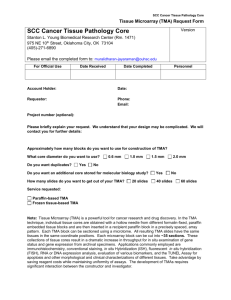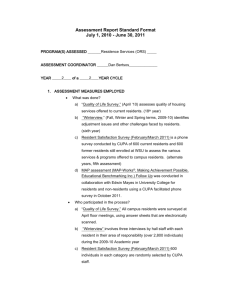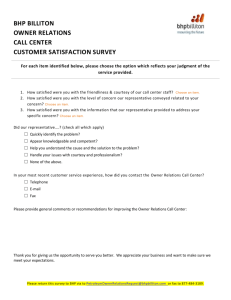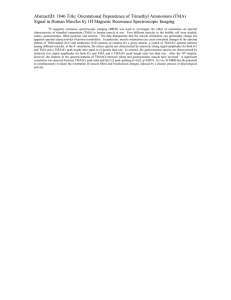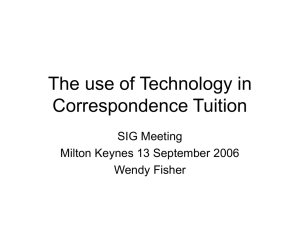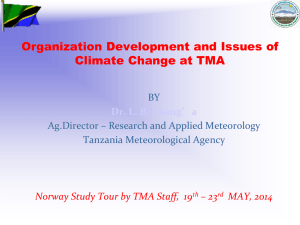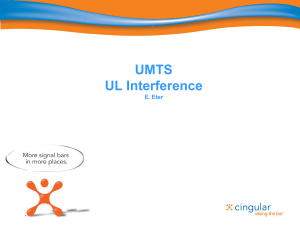Iowa State University Department of Residence 2001-02 Student Maintenance Request Survey Summary
advertisement
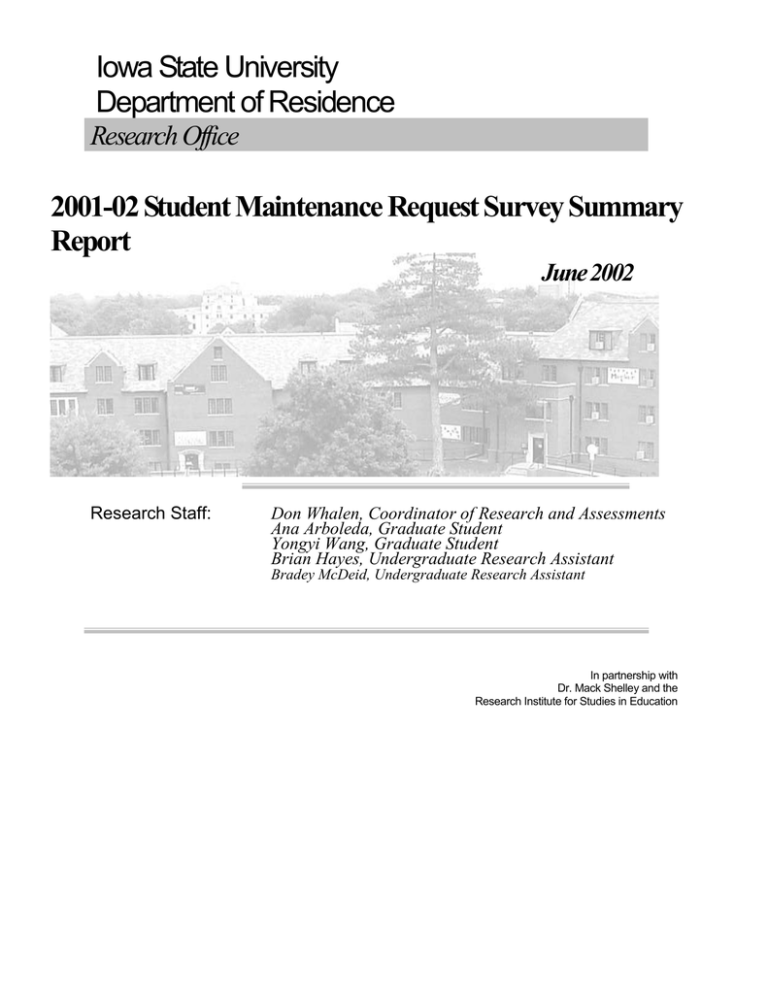
Iowa State University Department of Residence Research Office 2001-02 Student Maintenance Request Survey Summary Report June 2002 Research Staff: Don Whalen, Coordinator of Research and Assessments Ana Arboleda, Graduate Student Yongyi Wang, Graduate Student Brian Hayes, Undergraduate Research Assistant Bradey McDeid, Undergraduate Research Assistant In partnership with Dr. Mack Shelley and the Research Institute for Studies in Education Iowa State University Department of Residence 2001-2002 TMA Survey The Maintenance Authority (TMA) survey assesses residents’ satisfaction with maintenance service regarding timeliness, courtesy, and thoroughness. Results indicate that overall resident satisfaction with maintenance service is high. The majority of residents are satisfied with maintenance service courtesy and quality. Results show that average response times to complete repairs have shortened, and therefore, students are more satisfied with this area of maintenance work than in years past. The Survey The 2001-2002 Maintenance Authority (TMA) survey was distributed to residents who had recently received maintenance service from the Department of Residence (DOR). The overall response rate for the survey was 37.4% as 871 out of 2327 emailed surveys were returned. Response rates for individual resident communities can be seen in Table 1. The TMA Survey consisted of six questions using a 5-point scaled response: 1=Strongly disagree, 2=Disagree, 3=Neutral, 4=Agree, 5=Strongly agree. “Cannot answer” was also an option for all six questions. An additional two questions used a simple “Yes,” “No,” or “Not sure” response. A written comment section was also present on the survey. These comments in combination with the data presented here will allow maintenance supervisors to evaluate both overall student satisfaction and individual employee performance. Methods At the end of each week, the Service Center provided the research office with a list of work orders completed during the previous week throughout the DOR, excluding orders that were for routine preventative maintenance. Multiple requests from the same resident were eliminated (preventing a resident from being surveyed more than once in a week), as were requests from staff and residents who were moving out. The reduced database was then sampled. Computer macros created by Alfred Mukamuri were implemented to make the process more efficient. The new macros selected a random sample of 100 work orders each week. The average total sample size approximated 85 each week because e-mail addresses were not available for every selected case. Using Microsoft Mailmerge, surveys were addressed and tailored specifically for individual students who had work completed. Results In general, resident feedback for the TMA Survey was positive. Overall results are shown in Table 2. The mean on all of the scaled-response questions was greater than 4.30. The most positive feedback came in the area of worker courtesy (4.67). Also receiving satisfaction means of at least 4.50 was the worker(s) cleaned up after themselves (4.55), and the dispatcher who took my call was courteous (4.50). Receiving relatively lower ratings were the overall repair was completed to your satisfaction (4.37), I would want the same worker(s) to complete another job (4.31), and I was satisfied with the response time for the repair (4.31). Even though this statement produced a relatively low mean, it was the only item that residents were significantly more satisfied with when compared to the two previous years. At the time they filled out the survey, 82.7% of respondents said that the work they requested had been completed. When asked if a copy of the work order was left to alert them that the work has been completed, 45.7% said no, 32.5% said yes, and the remaining students did not know or chose not to indicate. Table 3 gives the overall service time statistics. The most frequent response time was zero days (41.4%), indicating that the repair was completed the same day the request was called in by the student. The average response time was 5.60 days; this figure is down from an average of 8.44 days given in the 2000-2001 TMA Survey Report. Almost 85% of repair requests required 10 service days or less (Table 4). Conclusion The results of the 2001-2002 TMA Survey reflect positively on the efforts of the maintenance staff. The mean for every benchmark were higher from the previous two years. Results suggest that the majority of residents are satisfied with courtesy, quality, and response of the DOR maintenance staff. The high mean score and percentage of respondents who strongly agreed that the worker(s) were courteous indicates consistent success in this area since it was also a strength in the two previous TMA surveys. The average number of service days required to complete work orders was less than in previous years and, as a result, students are more satisfied in this area of maintenance service.


